Welcome to Namibia!
- You will land at Hosea Kutako International Airport [WDH], Windhoek, Namibia
- At the airport, meet our representative. Itinerary briefing and pick-up of your rental vehicle
- Drive to Windhoek
- Stay at Villa Violet, in 2 rooms for 1 night
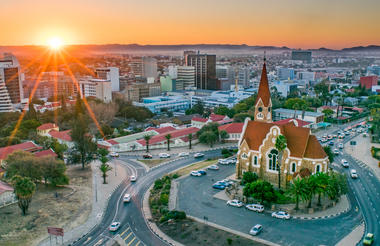


- WDH Airport - Villa Violet: 50 km, about 40 min
GPS Coordinate conversion
If your GPS requires coordinates in degrees, minutes, and seconds, here is the conversion:
- Latitude: -22.554947644987486 = -22° 33' 17.8086" or South 22° 33' 17.81"
- Longitude: 17.096274515148327 = 17° 5' 46.5894" or East 17° 5' 46.59"
How to get them?
- -22.554947644987486 >> 22 degrees
- 0.554947644987486 x 60 = 33.29685869924916 >> 33 minutes
- 0.29685869924916 x 60 = 17.8115219549496 >> 17.81 seconds
- For the Longitude, the same process
Restaurants
Advance booking is required. The hotel manager can book them for you.
- Joe's Beerhouse (game meat) 160 Nelson Mandela Ave, Windhoek, +264 61 232 457: https://www.joesbeerhouse.com/
- The Fisher, Hidas Centre, 21, 21 Nelson Mandela Ave, Windhoek, +264 81 166 1126
- Isabel's Table C/O Robert Mugabe and, Liliencron Street, Windhoek, +264 81 355 3253
Grocery
SUPERSPAR Maerua, Centaurus Street, Windhoek
Pick n Pay, Wecke Street, Windhoek
- Rental 4x4 vehicle for the duration of the trip
- Breakfast
- Complimentary wifi
- Activities stated as planned
- Fuel for your vehicle
- Lunch and dinner
- All drinks
- Laundry
- All activities stated as recommended or optional
- Self-drive itinerary to Otjiwarongo
- Stay at Out of Africa Town Lodge for 1 night
- Aug 6th: enjoy the CCF Cheetah Conservation Fund, the most famous Cheetah Safari and Education Center
Cheetah Conservation Fund
It is a research project and lobby institution in Namibia concerned with studying and sustaining the country's cheetah population, the largest and healthiest in the world. Its Research and Education Centre is 44 kilometers (27 mi) east of Otjiwarongo. The CCF was founded in 1990 by conservation biologist Laurie Marker who won the 2010 Tyler Prize for her efforts in Namibia. Loss of habitat, conflict with humans, and its own loss of genetic variation are the main threats facing the cheetah today. Both within Namibia and worldwide, there is now far greater awareness of the value of the cheetah within the ecosystem and its endangered status. Encouragingly, increasing numbers of Namibian farmers (on whose land the majority of wild cheetahs live) are implementing predator-friendly livestock management techniques. CCF's conservation and educational efforts are supported by ongoing research to develop policies and programs to sustain the cheetah population in Namibia and as a model for cheetah conservation programs in other countries such as Botswana, Kenya, South Africa, Algeria, and Iran.


- Villa Violet - Out of Africa Town Lodge : 250 km, about 3h
We recommend shopping in Windhoek for your first picnic lunch
- Rental 4x4 vehicle for the duration of the trip
- CCF Cheetah Conservation Fund entrance
- Breakfast and dinner
- Activities stated as planned
- Fuel for your vehicle
- Cheetah Run and Cheetah Feed Experiences
- Lunch - picnic lunch available upon request on the travel days
- All drinks
- Wifi
- Laundry
- All activities stated as recommended or optional
Welcome to Etosha!
- Self-drive itinerary and safari to the eastern gate of Etosha NP
- Enjoy your safaris in Etosha NP
- Stay at Namutoni Resort for 2 nights
- August 7th: morning guided safari in Etosha East with the park rangers
Etosha National Park
Regarded by safari enthusiasts as one of Africa's greatest wildlife sanctuaries, Etosha National Park - dominated by its enormous shimmering salt pan - is an area of wild savannah, umbrella thorn acacias, and mopane woodland and is home to a fantastic array of animals. The park measures 22,935 sq km, while all the pans cover more than 4,730 sq km. Despite its arid appearance, the park is packed with familiar faces and protects over 100 species of mammal, 16 species of reptile, and 340 species of bird. "Etosha" means "great white place of dry water" and comes from the Etosha Pan, a vast, flat, saline desert. When a good rainy season occurs, the normally dry river channels carry water to this gentle depression turning it into a shallow lagoon. This unusual oasis then becomes a busy watering hole as it draws in a variety of animals and, for a few days each year, thousands of flamingos and pelicans. You are likely to see elephants, giraffes, lions, leopards, Burchell's zebra, and the desert specialists like springbok and the handsome gemsbok. It's also one of the best places in southern Africa to spot the endangered cheetah and black rhino, not to mention rare antelope species like black-faced impala, Damara dik-dik, and roan antelope. The birds include an exciting blend of savannah, wetland, and semi-desert birds such as korhaan, marabou, yellow-billed hornbill, ostrich, white-backed vulture, and the enormous kori bustard, which can exceed 15kg in weight. Visitors can explore the pans in their own vehicles, and detailed maps and game guides are offered on entry.

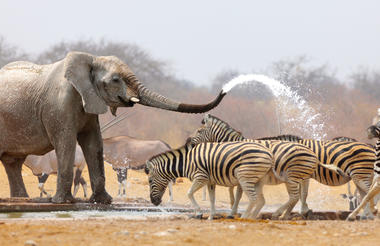
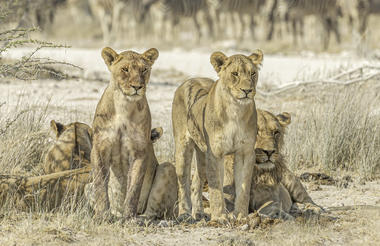
- Out of Africa Town Lodge - CCF Cheetah Conservation Fund: 50 km, about 1h
- CCF Cheetah Conservation Fund - Namutoni Camp: 320 km, about 3h30'-4h
General
- Etosha NP entrance fee: 150 NAD per person per day (10 USD)
Night Game Drive
- Rental 4x4 vehicle for the duration of the trip
- Breakfast and dinner
- 1 morning guided safari
- Activities stated as planned
- Fuel for your vehicle
- Etosha NP entrance fees
- Additional guided safaris
- Lunch - picnic lunch available upon request on the travel days
- All drinks
- Wifi
- Laundry
- All activities stated as recommended or optional
- Self-drive itinerary and safari in the central Etosha NP
- Enjoy your self-drive safaris in central Etosha NP
- Stay at Halali Resort for 1 night
- Night guided safari in Etosha East with the park rangers


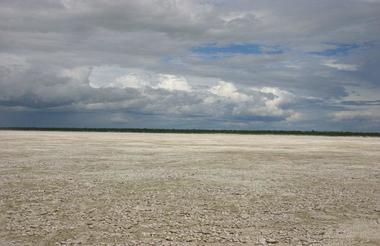
Spend some time at Halali Waterhole!
- Namutoni Camp - Halali Camp: 70 km, about 2h
- Take your time exploring Etosha NP in self-drive!
General
- Etosha NP entrance fee: 150 NAD per person per day (10 USD)
Halali Waterhole
- Rental 4x4 vehicle for the duration of the trip
- Breakfast and dinner
- 1 night guided safari
- Activities stated as planned
- Fuel for your vehicle
- Etosha NP entrance fees
- Additional guided safaris
- Lunch - picnic lunch available upon request on the travel days
- All drinks
- Wifi
- Laundry
- All activities stated as recommended or optional
- Self-drive itinerary and safari to Etosha South/West
- Explore at your pace the waterholes
- Stay at Okaukuejo Resort for 1 night
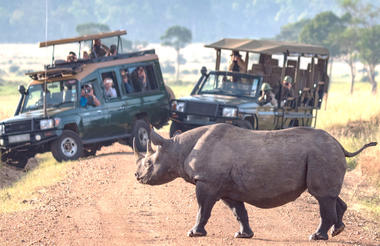
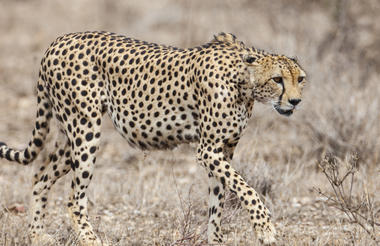
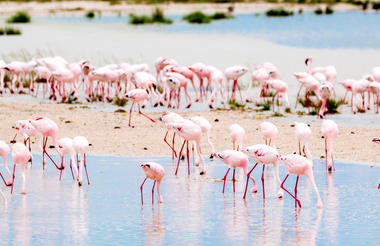
In the evening, spend some time at Okaukuejo Waterhole!
- Halali Camp - Okaukuejo Camp : 70 km, about 2h
- Take your time exploring Etosha NP in self-drive!
General
- Etosha NP entrance fee:150 NAD per person per day (10 USD)
- Rental 4x4 vehicle for the duration of the trip
- Breakfast and dinner
- Activities stated as planned
- Fuel for your vehicle
- Etosha NP entrance fees
- Additional guided safaris
- Lunch - picnic lunch available upon request on the travel days
- All drinks
- Wifi
- Laundry
- All activities stated as recommended or optional
Welcome to the arid land of Damara!
- Self-drive itinerary to Damaraland
- Stay at Twyfelfontein Country Lodge for 1 night
Damaraland
The name of this region comes from the Damara people who live here and constitute a large share of its very low population. The region is also home to various games, including zebra, giraffe, antelope, elephant, and black rhino. Damaraland is famous for its numerous, intriguing natural landmarks such as the Petrified Forest, the volcanic Burnt Mountain, and the basalt Organ Pipes, a peculiar geological feature comprising numerous 12-foot high dolerite columns. Damaraland incorporates the Brandberg, Twyfelfontein, and Spitzkoppe and is renowned for its incredible prehistoric rock paintings and engravings. Brandberg means ‘fire mountain’ and is so called because of the setting sun's effect on its western face. At 8,550 feet, its summit is Namibia’s highest peak. Here you will find the Tsisab and Numas ravines, both displaying many weird and wonderful rock paintings.

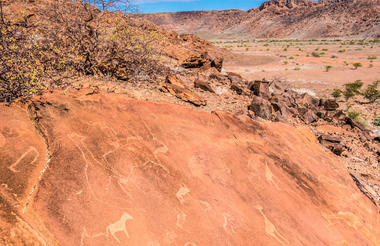
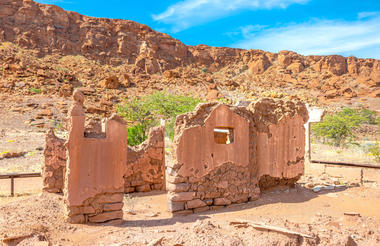
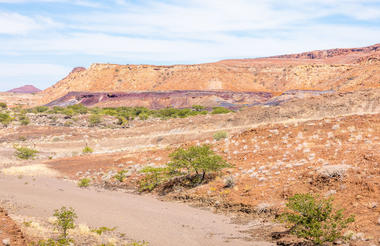
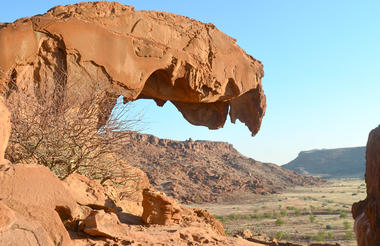
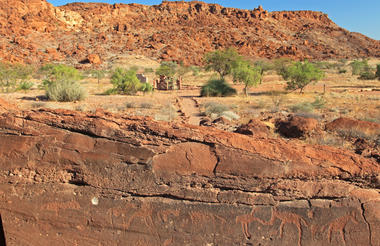
- Okaukuejo Camp - Twyfelfontein Country Lodge : 350 km, about 4h
An early departure from Etosha is recommended. As activities, we suggest:
- Twyfelfontein Rock Art
Desert Elephant Guided Safari OR Damara Living Museum
All the others, only if you really have the time. Please, don't be in a rush and enjoy your holiday!
Desert Elephant Guided Safari
- Rental 4x4 vehicle for the duration of the trip
- Breakfast and dinner
- Activities stated as planned
- Fuel for your vehicle
- Attraction entrance fees
- Guided safaris
- Lunch - picnic lunch available upon request on the travel days
- All drinks
- Wifi
- Laundry
- All activities stated as recommended or optional
Let's reach the Ocean!
- Self-drive itinerary to the Ocean
- Stay at Atlantic Villa for 2 nights
- Guided 4x4 tour to the Sandwich Harbour Dunes with picnic lunch
Swakopmund
It looks like being in Germany! Swakopmund, known as Swakop in Namibia, is the country’s biggest coastal town and a resort for Namibians on holiday. The city’s German origins are quite pronounced in beautiful old German colonial buildings throughout the city, making an even starker contrast for this town sitting at the edge of the Namib Desert. Why would we like our clients to stay in Swakopmund? Beautiful dunes, a vibrant city, and above all, Sandwich Harbour. Once you obtain the permit (instructions will be given), you drive along a beautiful dune chain adjacent to the Atlantic Ocean, zigzagging the original railway line between Swakopmund and Walvis Bay. This is an opportunity for a detailed look at the formation of ‘the world’s oldest desert’ and the bird paradise surrounding you. The dramatic landscape will capture your imagination as soon as you get close to the dunes and the ocean. It will quickly become clear why Sandwich Harbour is often described as inaccessible! Spring tides and shifting sands ensure an unpredictable route, but as you approach the towering, wind-sculptured dunes at the edge of Sandwich Harbour, there is a sense of entering a different world. You will drive on a thin stretch of sand between the dunes and the ocean. A truly unique experience.
The Zeila Shipwreck
The Zeila Shipwreck is an offshore fishing vessel that ran aground in 2008. Namibia’s infamous ‘Skeleton Coast’, nicknamed the "The Land God Made in Anger", and "The Gates of Hell," is a desolate stretch of desert running right to the sea, where the cold Benguela current creates strong currents, rough seas, and dense fogs. The latter in particular, have been responsible for the thousand or so shipwrecks along the coast. A great photo-op, especially with the roosting birds that have taken up residence on it, the Zeila is a reminder of the power of nature at the ‘End of the Earth’ where lions hunt seals, and elephants wade through the surf.
Cape Cross Seal Reserve
Cape Cross has historical and biological significance and is a popular tourist attraction. The Portuguese navigator, Diego Cão, landed here in 1486 on his second expedition south of the equator and planted a stone cross (padrão) to mark his journey. A replica is visible here today. Inclusive of a second replica, the area has been listed as a National Heritage Site. In the late 1800s, thousands of tons of guano (dried excrement of fish-eating birds used as fertilizer) were collected and exported to Europe. Cape fur seals were also harvested. About 100 workers lived at Cape Cross, and a police station, customs, and post office were established at the settlement, while a railway (the first in the country) was built to cross the salt pan and transport workers. Many men lost their lives due to the harsh conditions at Cape Cross. This reserve is a sanctuary for the world’s largest Cape for seals breeding colony, with up to 210,000 seals present during the breeding season in November and December. Sustainable seal harvesting occurs in reserve annually under the Ministry of Fisheries and Marine Resources auspices, which also sets the quota of seals to be harvested.
Sandwich Harbour
It is an area on the Atlantic coast of Namibia that includes a bay in the north and a lagoon at the southern end. Formerly the bay was a moderately-sized commercial port based around whaling and small-scale fishing, but it is now best known for its birdlife in the lagoon to the south of the bay. Sandwich Harbour, part of the Namib Naukluft Park, is a place many have heard of but very few have ever visited. The lagoon, salt pans, and the bird sanctuary, which form the Walvis Bay Wetlands, are rightly heralded as the single most important coastal wetlands of Southern Africa. It is one of five Ramsar sites in Namibia. Giant sand dunes run straight into the ocean, creating breathtaking sceneries and unique landscapes, just waiting to be discovered!
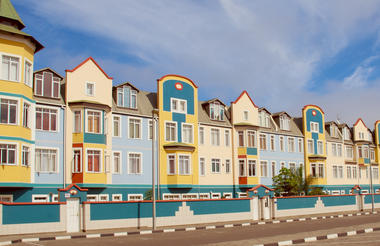
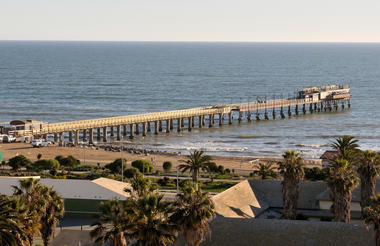
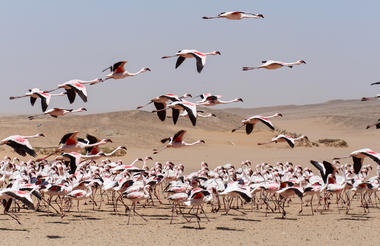
An early departure from Twyfelfontein is recommended
- Twyfelfontein Country Lodge - Cape Cross Seal Reserve: 320 km, about 4h30'
- Cape Cross Seal Reserve - Zeila Shipwreck: 75 km, about 1h
- Zeila Shipwreck - Atlantic Villa: 55 km, about 40 min
General
- Cape Cross Seal Colony Fees: 40 NAD per person + 10 NAD per vehicle
Restaurants - Cape Cross
- Lunch between Twyfelfontein and Cape Cross at Cape Cross Lodge. Advance booking is recommended (+264 64 694 012): https://www.capecross.org/
Restaurants - Swakopmund
- Ocean Cellar (+264 64 411 4410, Molen Weg Swakopmund); it's my best fish restaurant in Swakopmund!
- from Travel News Namibia: http://www.travelnewsnamibia.com/news/ten-restaurants-in-swakopmund-you-have-to-try/
- from AfriStay Travel Blog: https://www.afristay.com/blog/top-15-restaurants-in-swakopmund/
Swakopmund Town
- Rental 4x4 vehicle for the duration of the trip
- Breakfast
- Sandwich Harbour Tour
- Activities stated as planned
- Fuel for your vehicle
- Park, attraction, and museums entrance fees
- Lunch and dinner
- Lunch - picnic lunch available upon request on the travel days
- All drinks
- Wifi
- Laundry
- All activities stated as recommended or optional
Welcome to the Namib Desert!
- Self-drive itinerary to the Namibian Kalahari
- August 6th: enjoy the Guided Halfday 4x4 Sossusvlei Excursion with picnic breakfast
- Stay at Desert Camp for 2 nights
Enjoy your time at leisure in the dune landscape of the Kalahari Desert. You can view different specially adapted game species at a nearby waterhole or take the day off to relax and swim in the pool.
Namibian Kalahari
The Kalahari is the vastest coherent sand plain worldwide. It's a semi-desert ecosystem that forms the most extensive coherent sand plain worldwide. The Kalahari is part of a vast sand basin that covers eastern and southern Namibia, large amounts of Botswana, and the north-western area of South Africa. The Kalahari Desert isn't a real desert as it receives too much rain. It can instead be called a fossil desert. The look of the Kalahari is characterized by little grass clumps and red dunes. They are not very high but long and have a sharp crest. Spot African wildlife like black-maned Kalahari lions, oryxes, giraffes, warthogs, or little meerkats (suricates) on game drives, while enjoying the silence around you. This area in Namibia is inhabited by the San people (Namibian bushmen), who used to be hunter-gatherers. They now survive by game hunting and collecting edible plants, like berries or desert melons.
Sossusvlei and Dead Vlei
One of the most extraordinary sights in Namibia, if not the world. The eternally shifting red dunes tower 300 m over the Namib desert (the
the oldest desert in the world) and its ancient clay pans. The dunes in the Namib Naukluft Park formed on the coast and gradually shifted inland for millions of years. This endless wind pushing sand ever forward creates the fantastic shapes for which Sossusvlei has become so famous. The pans rarely get water, but on the rare occasion the Namib does see rain, the pans spring into life. Trees once grew here, but these have long since died, their dried and blackened skeletons still standing 900 years later. To experience the true beauty of these vast structures, they should be climbed at sunrise or sunset when the colors and shapes transform before your eyes. The gates to the dunes open an hour before sunrise. Then, a 60km drive along the tar road through the park before you reach the famous pans. Along this road, you will see a sign for Dune 45; this is an excellent place to watch the sunrise over the dunes. It is also a slightly easier dune to climb. If you prefer to avoid crowds, keep driving to Dead Vlei. The last 5km is through deep sand and is for 4x4 vehicles; the signs for Dead Vlei and experience the extraordinary beauty of this pan before anyone else arrives.
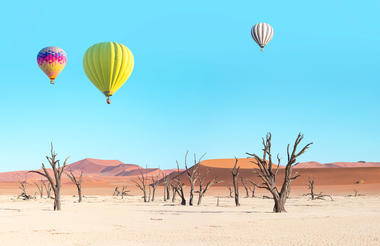


An early departure from Swakopmund is recommended
- Atlantic Villa - Desert Camp: 350 km, about 5h
Departure for Sossusvlei and Deadvlei excursion: Sossusvlei Lodge - Adventure Centre
- Rental 4x4 vehicle for the duration of the trip
- Breakfast and dinner
- Guided tour to Sossusvlei and Deadvlei
- Activities stated as planned
- Fuel for your vehicle
- Lunch - picnic lunch available upon request on the travel days
- All drinks
- Wifi
- Laundry
- All activities stated as recommended or optional
- Self-drive itinerary back to Windhoek
- Stay at The Elegant Guesthouse for 1 night
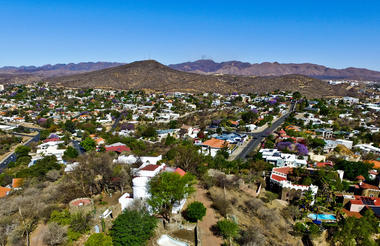
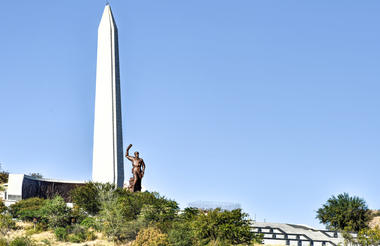
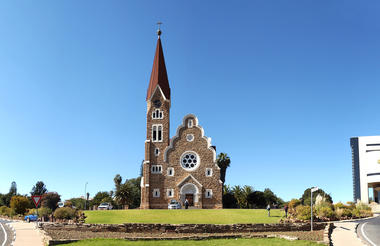
- Desert Camp - Windhoek: 350 km, about 5h
- Rental 4x4 vehicle for the duration of the trip
- Breakfast
- Complimentary wifi
- Activities stated as planned
- Fuel for your vehicle
- Lunch and dinner
- All drinks
- Laundry
- All activities stated as recommended or optional
- Self-drive itinerary back to Hosea Kutako International Airport [WDH]
- Drop-off of the rental vehicle and debriefing
Please note the car rental requires the drop-off of the vehicle with FULL fuel tank
- The Elegant Guesthouse - WDH Airport: 50 km, about 40 min
- Consider some extra time for the vehicle drop-off and debriefing
- Breakfast





